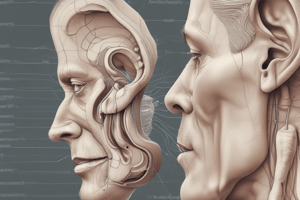Podcast
Questions and Answers
What is the primary role of the pinna in the outer ear?
What is the primary role of the pinna in the outer ear?
- Amplifying sound waves
- Converting sound vibrations into electrical impulses
- Collecting and directing sound waves into the ear canal (correct)
- Equalizing air pressure within the ear
Which of the following structures is NOT part of the inner ear?
Which of the following structures is NOT part of the inner ear?
- Eardrum (correct)
- Semicircular canals
- Vestibule
- Cochlea
How do sound waves initially affect the ear when they enter the outer ear?
How do sound waves initially affect the ear when they enter the outer ear?
- They create electrical impulses directly.
- They are filtered by the ossicles.
- They cause the cochlea to vibrate.
- They vibrate the eardrum. (correct)
What is the function of the ossicles in the middle ear?
What is the function of the ossicles in the middle ear?
Which part of the cochlea is responsible for processing different sound frequencies?
Which part of the cochlea is responsible for processing different sound frequencies?
What does the Eustachian tube do in the middle ear?
What does the Eustachian tube do in the middle ear?
What kind of energy do sound vibrations become after being processed by the hair cells in the cochlea?
What kind of energy do sound vibrations become after being processed by the hair cells in the cochlea?
Which structure serves as the membrane-covered entrance to the cochlea?
Which structure serves as the membrane-covered entrance to the cochlea?
Study Notes
Sound Wave Transmission
- Sound waves travel through the air as vibrations.
- They enter the ear and cause the eardrum to vibrate.
- Vibrations are converted into mechanical energy and transmitted through the ear structures.
Anatomy of the Ear
- Outer Ear: Comprises the pinna (external ear) and the ear canal.
- Middle Ear: Contains the eardrum and ossicles (malleus, incus, stapes).
- Inner Ear: Houses the cochlea, vestibule, and semicircular canals.
Outer Ear Functions
- Pinna: Collects sound waves and funnels them into the ear canal.
- Ear Canal: Directs sound waves toward the eardrum and protects inner structures from debris.
- Plays a role in sound localization by altering the sound's direction based on the shape and position of the pinna.
Cochlear Function
- The cochlea is a spiral-shaped, fluid-filled structure.
- Converts mechanical vibrations from the ossicles into neural signals.
- Contains hair cells (sensory cells) that transduce sound vibrations into electrical impulses.
- Different frequencies are processed along the cochlea’s length (tonotopic organization).
Middle Ear Components
- Eardrum (Tympanic Membrane): Vibrates in response to sound waves and separates the outer and middle ear.
- Ossicles: Three tiny bones (malleus, incus, stapes) that amplify and transmit vibrations from the eardrum to the inner ear.
- Eustachian Tube: Equalizes air pressure on both sides of the eardrum, critical for proper vibration transmission.
- Oval Window: Membrane-covered entrance to the cochlea, where stapes transmits vibrations into the inner ear.
Sound Wave Transmission
- Sound waves are vibrations that travel through air, entering the ear and causing the eardrum to vibrate.
- Vibrations are converted into mechanical energy and transmitted through various ear structures.
Anatomy of the Ear
- The ear is divided into three main parts: outer ear, middle ear, and inner ear.
- Outer Ear: Composed of the pinna (external ear) and the ear canal.
- Middle Ear: Includes the eardrum and ossicles, which consist of the malleus, incus, and stapes.
- Inner Ear: Contains the cochlea, vestibule, and semicircular canals.
Outer Ear Functions
- The pinna collects sound waves, funneling them into the ear canal.
- The ear canal directs sound waves toward the eardrum, protecting inner structures from debris.
- The pinna's shape and position assist in sound localization by altering sound direction.
Cochlear Function
- The cochlea is a spiral-shaped, fluid-filled structure crucial for sound processing.
- Converts mechanical vibrations from the ossicles into neural signals.
- Contains hair cells that transduce sound vibrations into electrical impulses.
- Frequencies are processed along the cochlea’s length, demonstrating tonotopic organization.
Middle Ear Components
- Eardrum (Tympanic Membrane): Vibrates in response to sound, acting as a barrier between the outer and middle ear.
- Ossicles: Three small bones (malleus, incus, stapes) amplify and transfer vibrations from the eardrum to the inner ear.
- Eustachian Tube: Balances air pressure on both sides of the eardrum, essential for effective vibration transmission.
- Oval Window: The membrane-covered entrance to the cochlea, where vibrations from the stapes are transmitted into the inner ear.
Studying That Suits You
Use AI to generate personalized quizzes and flashcards to suit your learning preferences.
Description
Explore the fascinating mechanics of sound wave transmission and the detailed anatomy of the ear. This quiz covers the functions of the outer, middle, and inner ear, highlighting key structures and their roles in hearing. Test your knowledge on how sound waves are transformed into neural signals.



